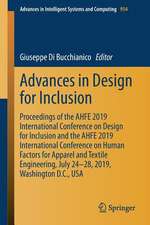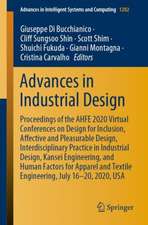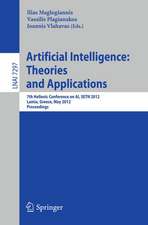Advances in Design for Inclusion: Proceedings of the AHFE 2017 International Conference on Design for Inclusion, July 17–21, 2017, The Westin Bonaventure Hotel, Los Angeles, California, USA: Advances in Intelligent Systems and Computing, cartea 587
Editat de Giuseppe Di Bucchianico, Pete F Kercheren Limba Engleză Paperback – 12 iun 2017
The book explores some of the overlaps between inclusive design and web accessibility to help managers, designers, developers, policy makers, and researchers optimize their efforts in these areas. Based on the AHFE 2017 International Conference on Design for Inclusion, held on July 17–21, 2017 in Los Angeles, California, USA, it discusses new design technologies and highlights the disparate needs of the individuals within a community. Thanks to its multidisciplinary approach, the book represents a useful resource for readers withvarious backgrounds, providing them a timely, practice-oriented guide to design for inclusion.
Din seria Advances in Intelligent Systems and Computing
- 20%
 Preț: 1120.87 lei
Preț: 1120.87 lei - 20%
 Preț: 1090.59 lei
Preț: 1090.59 lei - 20%
 Preț: 1324.07 lei
Preț: 1324.07 lei - 20%
 Preț: 1989.79 lei
Preț: 1989.79 lei - 20%
 Preț: 1946.92 lei
Preț: 1946.92 lei - 18%
 Preț: 1273.28 lei
Preț: 1273.28 lei - 20%
 Preț: 2264.51 lei
Preț: 2264.51 lei - 20%
 Preț: 1337.27 lei
Preț: 1337.27 lei - 20%
 Preț: 1297.67 lei
Preț: 1297.67 lei - 20%
 Preț: 1315.82 lei
Preț: 1315.82 lei - 20%
 Preț: 1310.88 lei
Preț: 1310.88 lei - 20%
 Preț: 1302.62 lei
Preț: 1302.62 lei - 20%
 Preț: 882.19 lei
Preț: 882.19 lei - 20%
 Preț: 1305.93 lei
Preț: 1305.93 lei - 20%
 Preț: 1629.32 lei
Preț: 1629.32 lei - 20%
 Preț: 1345.49 lei
Preț: 1345.49 lei - 18%
 Preț: 1227.52 lei
Preț: 1227.52 lei - 18%
 Preț: 1290.64 lei
Preț: 1290.64 lei - 20%
 Preț: 1041.10 lei
Preț: 1041.10 lei - 20%
 Preț: 1034.52 lei
Preț: 1034.52 lei - 20%
 Preț: 1298.50 lei
Preț: 1298.50 lei - 20%
 Preț: 1330.67 lei
Preț: 1330.67 lei - 20%
 Preț: 1483.28 lei
Preț: 1483.28 lei - 20%
 Preț: 1971.64 lei
Preț: 1971.64 lei - 20%
 Preț: 1006.48 lei
Preț: 1006.48 lei - 20%
 Preț: 1471.75 lei
Preț: 1471.75 lei - 20%
 Preț: 1471.56 lei
Preț: 1471.56 lei - 20%
 Preț: 1454.40 lei
Preț: 1454.40 lei - 20%
 Preț: 1494.84 lei
Preț: 1494.84 lei - 20%
 Preț: 1269.64 lei
Preț: 1269.64 lei - 20%
 Preț: 1481.64 lei
Preț: 1481.64 lei - 20%
 Preț: 1192.08 lei
Preț: 1192.08 lei - 20%
 Preț: 1298.50 lei
Preț: 1298.50 lei - 20%
 Preț: 1489.07 lei
Preț: 1489.07 lei - 20%
 Preț: 825.78 lei
Preț: 825.78 lei - 20%
 Preț: 1649.93 lei
Preț: 1649.93 lei - 20%
 Preț: 1463.49 lei
Preț: 1463.49 lei - 20%
 Preț: 1438.77 lei
Preț: 1438.77 lei - 20%
 Preț: 1474.22 lei
Preț: 1474.22 lei - 20%
 Preț: 1298.50 lei
Preț: 1298.50 lei - 20%
 Preț: 1327.35 lei
Preț: 1327.35 lei - 20%
 Preț: 1973.31 lei
Preț: 1973.31 lei - 18%
 Preț: 947.04 lei
Preț: 947.04 lei - 18%
 Preț: 1441.39 lei
Preț: 1441.39 lei - 20%
 Preț: 638.55 lei
Preț: 638.55 lei - 20%
 Preț: 1320.76 lei
Preț: 1320.76 lei - 20%
 Preț: 1948.56 lei
Preț: 1948.56 lei
Preț: 1283.81 lei
Preț vechi: 1604.77 lei
-20% Nou
Puncte Express: 1926
Preț estimativ în valută:
245.65€ • 257.17$ • 203.26£
245.65€ • 257.17$ • 203.26£
Carte tipărită la comandă
Livrare economică 05-19 aprilie
Preluare comenzi: 021 569.72.76
Specificații
ISBN-13: 9783319605968
ISBN-10: 3319605968
Pagini: 528
Ilustrații: XIII, 528 p. 220 illus.
Dimensiuni: 155 x 235 mm
Greutate: 0.75 kg
Ediția:1st ed. 2018
Editura: Springer International Publishing
Colecția Springer
Seria Advances in Intelligent Systems and Computing
Locul publicării:Cham, Switzerland
ISBN-10: 3319605968
Pagini: 528
Ilustrații: XIII, 528 p. 220 illus.
Dimensiuni: 155 x 235 mm
Greutate: 0.75 kg
Ediția:1st ed. 2018
Editura: Springer International Publishing
Colecția Springer
Seria Advances in Intelligent Systems and Computing
Locul publicării:Cham, Switzerland
Notă biografică
Giuseppe Di Bucchianico
Born in Pescara in 1967, he is an architect, with a Masters in Ergonomics and Ph.D in technological and design innovation Culture (2001).
He has had teaching assignments at the University of Roma-La Sapienza, Politecnico di Milano, Palermo, Florence and Chieti-Pescara, where he currently teaches Design 2. She has participated in numerous national research related to the design of the application fields.
Conducts research mainly in the field of relationships and synergies between Design and Ergonomics, ie the relations between individuals, artifacts and environments for the development of a user-centered approach to type design, themes with which he has participated in numerous national conferences and International. The application areas were those of the industrial product and in particular the nautical design and, recently, the Design for All and ergonomics for sustainable development.
He has won numerous competitions and international architectural awards ( "subversive insertions" Use Institute in Verona) and design ( "Design Plus 2007", ISH Frankfurt). Professionally he has studied in Design, collaborating with numerous companies (including Gattocucine, Valcucine, Foster, Abis, Tecnolam), exposing at important exhibitions and events in Milan, Verona, Brussels, Moscow, Paris, Frankfurt, New York, receiving reviews in prestigious magazines.
It is representative of the Agency SDI (Italian Design System) of Chieti to the Assembly of the Territorial Delegation of the National Council for Design Research. As part of the IEA (International Ergonomics Association), he is co-Chair of the International Technical Subcommittee "Ergonomics and Design for Sustainability".
Pete Kercher
Pete Kercher graduated in law in the UK then worked in international youth politics (Vice-President, European Federation of Liberal and Radical Youth, 1975-77). Moving to Italy in 1978, he established a communications and design consulting agency, now KSDC Strategic Design and Communications.
Executive Officer of BEDA in 1988-94, he then represented Italy on its Board of Directors until 2002.
A founder member of EIDD – Design for All Europe in 1993 (President in 2003-7) and of its national counterpart Design for All Italy (President 1997-99), he is currently EIDD’s roving Ambassador. As President of EIDD, he focused on critical mass in terms of membership, of academic credibility (the definitive EIDD Stockholm Declaration© 2004) and of taking the message about Design for All out into the real world of business and public administration, both by targeting the European Commission, other international agencies and major international organisations operating in the private sector and by devising a cycle of major annual conferences: Culture for All (2005), Work for All (2006) and Tourism for All (2007).
He writes articles and manifestos for political, legal and design publications, chairs and addresses conferences, seminars, symposia and workshops all over Europe and the rest of the world and acts as consultant to many international projects, also serving as a member of the Group of Experts in Design at OHIM (now EUIPO) throughout its existence (2002-2008).
Born in Pescara in 1967, he is an architect, with a Masters in Ergonomics and Ph.D in technological and design innovation Culture (2001).
He has had teaching assignments at the University of Roma-La Sapienza, Politecnico di Milano, Palermo, Florence and Chieti-Pescara, where he currently teaches Design 2. She has participated in numerous national research related to the design of the application fields.
Conducts research mainly in the field of relationships and synergies between Design and Ergonomics, ie the relations between individuals, artifacts and environments for the development of a user-centered approach to type design, themes with which he has participated in numerous national conferences and International. The application areas were those of the industrial product and in particular the nautical design and, recently, the Design for All and ergonomics for sustainable development.
He has won numerous competitions and international architectural awards ( "subversive insertions" Use Institute in Verona) and design ( "Design Plus 2007", ISH Frankfurt). Professionally he has studied in Design, collaborating with numerous companies (including Gattocucine, Valcucine, Foster, Abis, Tecnolam), exposing at important exhibitions and events in Milan, Verona, Brussels, Moscow, Paris, Frankfurt, New York, receiving reviews in prestigious magazines.
It is representative of the Agency SDI (Italian Design System) of Chieti to the Assembly of the Territorial Delegation of the National Council for Design Research. As part of the IEA (International Ergonomics Association), he is co-Chair of the International Technical Subcommittee "Ergonomics and Design for Sustainability".
Pete Kercher
Pete Kercher graduated in law in the UK then worked in international youth politics (Vice-President, European Federation of Liberal and Radical Youth, 1975-77). Moving to Italy in 1978, he established a communications and design consulting agency, now KSDC Strategic Design and Communications.
Executive Officer of BEDA in 1988-94, he then represented Italy on its Board of Directors until 2002.
A founder member of EIDD – Design for All Europe in 1993 (President in 2003-7) and of its national counterpart Design for All Italy (President 1997-99), he is currently EIDD’s roving Ambassador. As President of EIDD, he focused on critical mass in terms of membership, of academic credibility (the definitive EIDD Stockholm Declaration© 2004) and of taking the message about Design for All out into the real world of business and public administration, both by targeting the European Commission, other international agencies and major international organisations operating in the private sector and by devising a cycle of major annual conferences: Culture for All (2005), Work for All (2006) and Tourism for All (2007).
He writes articles and manifestos for political, legal and design publications, chairs and addresses conferences, seminars, symposia and workshops all over Europe and the rest of the world and acts as consultant to many international projects, also serving as a member of the Group of Experts in Design at OHIM (now EUIPO) throughout its existence (2002-2008).
Textul de pe ultima copertă
This book addresses a range of topics in design, such as universal design, design for all, digital inclusion, universal usability, and accessibility of technologies regardless of people’s age, financial situation, education, geographic location, culture and language. It especially focuses on accessibility for people with auditory, cognitive, neurological, and visual impairments, ageing populations, and mobility for those with special physical needs.
The book explores some of the overlaps between inclusive design and web accessibility to help managers, designers, developers, policy makers, and researchers optimize their efforts in these areas. Based on the AHFE 2017 International Conference on Design for Inclusion, held on July 17–21, 2017 in Los Angeles, California, USA, it discusses new design technologies and highlights the disparate needs of the individuals within a community. Thanks to its multidisciplinary approach, the book represents a useful resource for readers with various backgrounds, providing them a timely, practice-oriented guide to design for inclusion.
The book explores some of the overlaps between inclusive design and web accessibility to help managers, designers, developers, policy makers, and researchers optimize their efforts in these areas. Based on the AHFE 2017 International Conference on Design for Inclusion, held on July 17–21, 2017 in Los Angeles, California, USA, it discusses new design technologies and highlights the disparate needs of the individuals within a community. Thanks to its multidisciplinary approach, the book represents a useful resource for readers with various backgrounds, providing them a timely, practice-oriented guide to design for inclusion.
Caracteristici
Offers a comprehensive perspective on accessibility in design Discusses some of the overlaps between inclusive design and web accessibility Highlights practical issues in universal design Includes supplementary material: sn.pub/extras

























